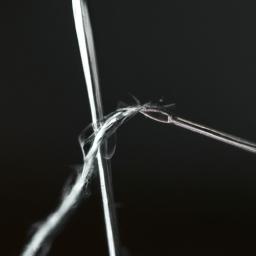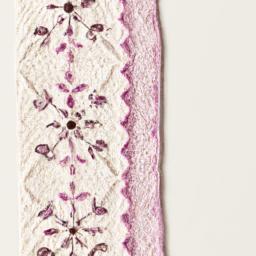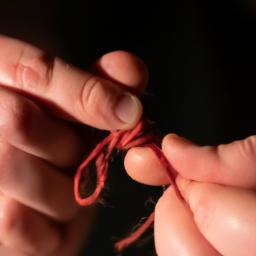Learn how to make decorative edging by forming knots in thread and add a personalized touch to your crafts. Discover the materials, knots, patterns, tips, and tricks to master this beautiful art form.
Are you looking for a unique way to add a personalized touch to your crafts and projects? Look no further than making decorative edging by forming knots in thread. This art form has been around for centuries and is still popular today for its intricate designs and endless possibilities.
Decorative edging with knots in thread is a simple yet beautiful way to elevate any project. From clothing to home decor, this technique can be used in a variety of ways to add a touch of elegance and uniqueness. Not only does it add a personal touch, but it also allows you to showcase your creativity and individuality.
In the following sections, we will explore the materials needed, basic knots, different patterns, tips, and tricks to master the art of making decorative edging with knots in thread. So, grab your thread and needle and let’s get started on this exciting journey.
Materials Needed

List of Materials
Before starting your decorative edging project, it’s important to gather all the necessary materials. Here’s a list of items you’ll need:
- Thread (cotton, silk, or embroidery floss)
- Needle (size depends on the thread thickness)
- Scissors
- Ruler or measuring tape
- Fabric or project to add the edging to
Importance of Choosing the Right Materials
Choosing the right type of thread and needle is crucial when making decorative edging with knots in thread. The thread’s thickness and texture will affect the final look of the edging, while the needle’s size will determine how easily the thread passes through the fabric.
For beginners, it’s recommended to use a thicker thread, such as cotton or embroidery floss, as it’s easier to handle and knot. As you become more experienced, you can experiment with different thread types and textures for more intricate designs.
It’s also important to choose a needle that’s appropriate for the thread thickness. A needle that’s too small will cause the thread to break or tangle, while a needle that’s too large will leave large holes in the fabric. Be sure to choose the right materials to ensure a successful and visually appealing decorative edging project.
Basic Knots

Explanation of Basic Knots Used in Making Decorative Edging
Before creating intricate patterns, it is essential to master the basic knots used in making decorative edging. There are three basic knots that every beginner should know: the loop knot, the double knot, and the square knot.
The loop knot is the foundation of decorative edging. It creates a loop at the end of the thread that can be used to start and finish the edging. The double knot is used to anchor the thread and create a more secure hold. The square knot is a combination of the loop knot and double knot and is commonly used in creating geometric patterns.
Step-by-Step Guide on How to Form the Knots
To create a loop knot, start by folding the thread in half and tying a knot at the end. Then, make a loop with the two strands of the thread, bringing the end of the loop under the knot. Pull tight to secure the loop in place.
To create a double knot, start by tying a loop knot at the end of the thread. Then, tie another knot on top of the loop knot, making sure to pull tight to secure the thread.
To create a square knot, start by folding the thread in half and tying a loop knot at the end. Then, tie a double knot on top of the loop knot. Next, tie another double knot, but this time, use the opposite strand of thread to tie the knot. Pull tight to secure the knot in place.
By mastering these basic knots, you will be well on your way to creating beautiful decorative edging with knots in thread.
Different Patterns

Are you ready to take your decorative edging with knots in thread to the next level? Let’s explore the different patterns you can create with this technique.
Introduction to Different Patterns
There are countless designs and patterns that you can create with decorative edging using knots in thread. From simple to intricate, each pattern has its own unique charm. Some popular patterns include the rope stitch, the twisted chain stitch, and the Chinese knot stitch.
Detailed Explanation of Each Pattern and How to Achieve Them
The Rope Stitch
The rope stitch is a simple yet elegant pattern that resembles a twisted rope. To achieve this pattern, start by creating a basic knot. Then, wrap the thread around the needle twice and insert the needle back into the same hole. Pull the thread tight to create a twisted loop. Repeat this process until you have created a rope-like effect.
The Twisted Chain Stitch
The twisted chain stitch is a more complex pattern that involves twisting the thread around the needle before inserting it back into the fabric. To create this pattern, start by creating a basic chain stitch. Then, twist the thread around the needle before inserting it back into the fabric. Pull the thread tight to create a twisted chain stitch. Repeat this process until you have created a twisted effect.
The Chinese Knot Stitch
The Chinese knot stitch is a unique and intricate pattern that resembles a knot. To achieve this pattern, start by creating a basic knot. Then, wrap the thread around the needle twice and insert the needle back into the same hole. Pull the thread tight to create a twisted loop. Repeat this process, alternating between the front and back of the fabric, until you have created a knot-like effect.
By experimenting with different patterns and designs, you can create a truly unique and personalized decorative edging with knots in thread.
Tips and Tricks

Embarking on a new craft can be daunting, but with these tips and tricks, you’ll be a pro in no time.
Useful Tips for Beginners
1. Start Simple
If you are new to decorative edging with knots in thread, start with a simple pattern before moving onto more intricate designs. This will help you get comfortable with the basic knots and build your confidence.
2. Use the Right Thread
Choosing the right thread is crucial when it comes to decorative edging with knots in thread. Use a high-quality thread that is strong and durable to ensure your edging lasts.
3. Practice Makes Perfect
Like any craft, practice makes perfect. Set aside some time to practice your knots and patterns, and don’t be discouraged if it takes a few tries to get it right.
Common Mistakes to Avoid
1. Pulling Too Tight
One of the most common mistakes beginners make is pulling the thread too tight. This can cause your edging to bunch up and look uneven. Make sure to keep the tension loose and even.
2. Skipping Steps
Decorative edging with knots in thread is a process that requires patience and attention to detail. Skipping steps or rushing can result in uneven or incomplete edging.
3. Not Using a Thimble
Using a thimble can help protect your fingers and make it easier to push the needle through the fabric. Don’t skip this important step, as it can make a big difference in your overall experience.
By following these tips and avoiding common mistakes, you’ll be able to master the art of making decorative edging with knots in thread in no time.
In Conclusion

In conclusion, making decorative edging by forming knots in thread is an excellent way to add a unique touch to your crafts and projects. With the right materials and a little bit of practice, anyone can master this art form and create beautiful designs.
Whether you’re looking to add a decorative edge to a piece of clothing or a home decor item, there are endless possibilities with this technique. And with the tips and tricks provided, you can avoid common mistakes and perfect your skills.
So, the next time you’re looking to add a personal touch to your crafts, give decorative edging with knots in thread a try. And for more inspiration and ideas, be sure to visit our website decorideasblog.com.
